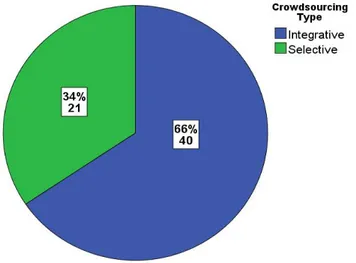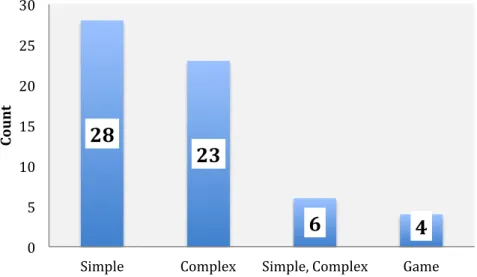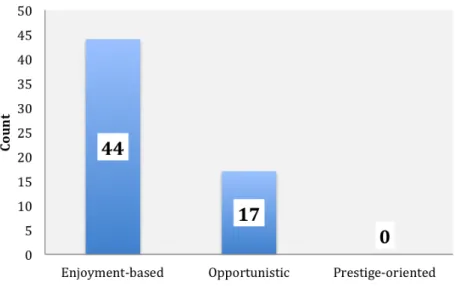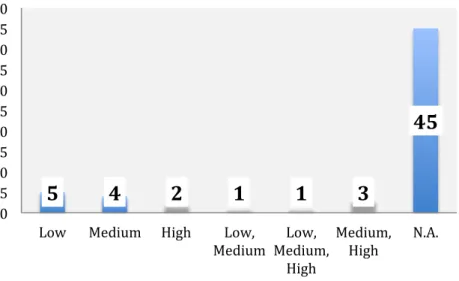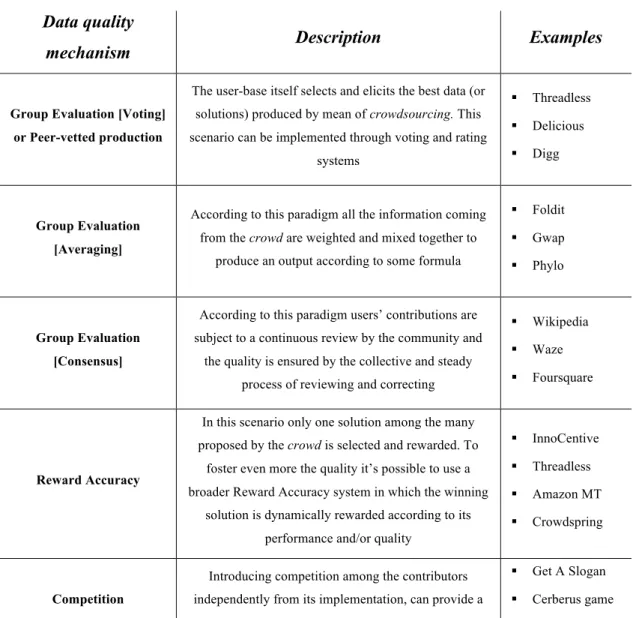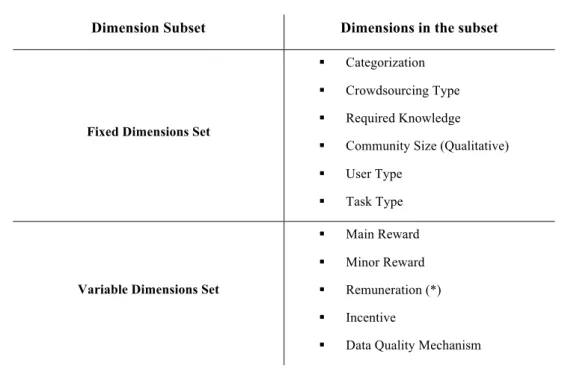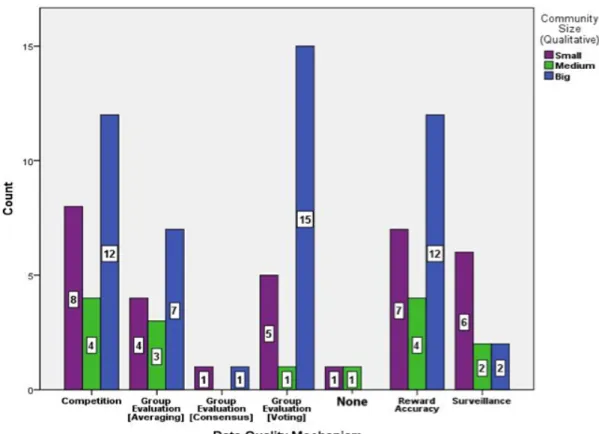POLITECNICO DI MILANO
Facoltà di Ingegneria dell’Informazione
Corso di Laurea Specialistica in Ingegneria Informatica
!"#$!"#$!%&'()*+,-./!#!0!*1+2!&+3!
!"#$%&'(!!"#$%&"#$'(#()*!%!'"#+%#"!
Relatore:
Prof.ssa Chiara Francalanci
Correlatore:
Prof. Eugenio Capra
Tesi di Laurea Specialistica di
Francesco Pongetti
Matricola 739280
To all the people I met in my life that showed me the correct handling of knives, books and wine such as my tools, wit and taste may be kept sharp
I
TABLE OF CONTENTS
!"#$%&'(&)'*!%*!+&,,,,,,,,,,,,,,,,,,,,,,,,,,,,,,,,,,,,,,,,,,,,,,,,,,,,,,,,,,,,,,,,,,,,,,,,,,,,,,,,,,,,,,,,,,,,,,,,,,,,,,,,,,,,,,,,,,,,,,,,,,,,,,,,,,,&-& $-+!&'(&(-./0%+&,,,,,,,,,,,,,,,,,,,,,,,,,,,,,,,,,,,,,,,,,,,,,,,,,,,,,,,,,,,,,,,,,,,,,,,,,,,,,,,,,,,,,,,,,,,,,,,,,,,,,,,,,,,,,,,,,,,,,,,,,,,,,,,,,,,,,,,,,&---& $-+!&'(&!"#$%+&,,,,,,,,,,,,,,,,,,,,,,,,,,,,,,,,,,,,,,,,,,,,,,,,,,,,,,,,,,,,,,,,,,,,,,,,,,,,,,,,,,,,,,,,,,,,,,,,,,,,,,,,,,,,,,,,,,,,,,,,,,,,,,,,,,,,,,,,,,,,,1& +'22"0-'&,,,,,,,,,,,,,,,,,,,,,,,,,,,,,,,,,,,,,,,,,,,,,,,,,,,,,,,,,,,,,,,,,,,,,,,,,,,,,,,,,,,,,,,,,,,,,,,,,,,,,,,,,,,,,,,,,,,,,,,,,,,,,,,,,,,,,,,,,,,,,,,,,,,&1--& "#+!0")!&,,,,,,,,,,,,,,,,,,,,,,,,,,,,,,,,,,,,,,,,,,,,,,,,,,,,,,,,,,,,,,,,,,,,,,,,,,,,,,,,,,,,,,,,,,,,,,,,,,,,,,,,,,,,,,,,,,,,,,,,,,,,,,,,,,,,,,,,,,,,,,,,,,,,,,&-3& ")4*'5$%6.2%*!+&,,,,,,,,,,,,,,,,,,,,,,,,,,,,,,,,,,,,,,,,,,,,,,,,,,,,,,,,,,,,,,,,,,,,,,,,,,,,,,,,,,,,,,,,,,,,,,,,,,,,,,,,,,,,,,,,,,,,,,,,,,,,,,&3-& !"#$%&'()&
-*!0'6/)!-'*7&+)'8%&'(&0%+%"0)9&"*6&2%!9'6'$'.:&,,,,,,,,,,,,,,,,,,,,,,,,,,,,,,,,,,,,,,,,,,,,,,,,,,,,,,,,,,,,,,,,,,,,,,,,,,,,&;& !"#$%&'(*&
#")4.0'/*6&0%1-%5&"*6&+!"!%&'(&"0!&,,,,,,,,,,,,,,,,,,,,,,,,,,,,,,,,,,,,,,,,,,,,,,,,,,,,,,,,,,,,,,,,,,,,,,,,,,,,,,,,,,,,,,,,,,,,,,,,,,,&<& !"#& $%&'()*+&,(%-""""""""""""""""""""""""""""""""""""""""""""""""""""""""""""""""""""""""""""""""""""""""""""""""""""""""""""""""""""""""""""""""""""""""-.& !"!& /,0)(1-(2-&34-+'(5)0-"""""""""""""""""""""""""""""""""""""""""""""""""""""""""""""""""""""""""""""""""""""""""""""""""""""""""""""""""""""-6& !"7& 8'(5)0(*'+,%9-"""""""""""""""""""""""""""""""""""""""""""""""""""""""""""""""""""""""""""""""""""""""""""""""""""""""""""""""""""""""""""""""""-##& !":& ;4%&,14%&-<%=>?0,0-"""""""""""""""""""""""""""""""""""""""""""""""""""""""""""""""""""""""""""""""""""""""""""""""""""""""""""""""""""""""""-!@& !"#$%&'(+&
2'6%$-*.&)0'56+'/0)-*.&"88$-)"!-'*+&,,,,,,,,,,,,,,,,,,,,,,,,,,,,,,,,,,,,,,,,,,,,,,,,,,,,,,,,,,,,,,,,,,,,,,,,,,,,,,,,,,,,,,,,,,,,&=>& 7"#& $%&'()*+&,(%-""""""""""""""""""""""""""""""""""""""""""""""""""""""""""""""""""""""""""""""""""""""""""""""""""""""""""""""""""""""""""""""""""""""-7@& 7"!& A1B,',+=>-C=&=04&-"""""""""""""""""""""""""""""""""""""""""""""""""""""""""""""""""""""""""""""""""""""""""""""""""""""""""""""""""""""""""""-7#& 7"7& C40+',B&,D4-E'=145('F-""""""""""""""""""""""""""""""""""""""""""""""""""""""""""""""""""""""""""""""""""""""""""""""""""""""""""""""""-7G& 7":& H'40+',B&,D4-E'=145('F-=%)-41B,',+=>-)=&=04&-=%=>?0,0-""""""""""""""""""""""""""""""""""""""""""""""-G#& !"#$%&'(,&
II :"#-$%&'()*+&,(%-"""""""""""""""""""""""""""""""""""""""""""""""""""""""""""""""""""""""""""""""""""""""""""""""""""""""""""""""""""""""""""""""""""""""""""-II& :"!-C40+',B&,(%-(2-&34-4JB4',14%&-""""""""""""""""""""""""""""""""""""""""""""""""""""""""""""""""""""""""""""""""""""""""""""""""""""-#@#& :"7-C40+',B&,(%-(2-&34-0+4%=',(0-""""""""""""""""""""""""""""""""""""""""""""""""""""""""""""""""""""""""""""""""""""""""""""""""""""""""-##!& :":-K34-4JB4',14%&-=%)-&34-B'40+',B&,D4-2'=145('F-""""""""""""""""""""""""""""""""""""""""""""""""""""""""""""""-##I& :".-;*'D4?-""""""""""""""""""""""""""""""""""""""""""""""""""""""""""""""""""""""""""""""""""""""""""""""""""""""""""""""""""""""""""""""""""""""""""""""""""""-#!#& :"6-K40&-9'(*B-)40+',B&,(%-"""""""""""""""""""""""""""""""""""""""""""""""""""""""""""""""""""""""""""""""""""""""""""""""""""""""""""""""""""-#!.& :"G-L40*>&0-"""""""""""""""""""""""""""""""""""""""""""""""""""""""""""""""""""""""""""""""""""""""""""""""""""""""""""""""""""""""""""""""""""""""""""""""""""-#7!& :"M-<%=>?0,0-(2-&34-'40*>&0-"""""""""""""""""""""""""""""""""""""""""""""""""""""""""""""""""""""""""""""""""""""""""""""""""""""""""""""""""""""-#67& :"I-K40&,%9-(2-&34-14&3()(>(9?-"""""""""""""""""""""""""""""""""""""""""""""""""""""""""""""""""""""""""""""""""""""""""""""""""""""""""-#G@& !"#$%&'(-& )'*)$/+-'*+&"*6&(/!/0%&6%1%$'82%*!+&,,,,,,,,,,,,,,,,,,,,,,,,,,,,,,,,,,,,,,,,,,,,,,,,,,,,,,,,,,,,,,,,,,,,,,,,,,,,,,,,,,,,,,,,,&;@;& #$$&./01(#&
%28-0-)"$&6"!"+%!&,,,,,,,,,,,,,,,,,,,,,,,,,,,,,,,,,,,,,,,,,,,,,,,,,,,,,,,,,,,,,,,,,,,,,,,,,,,,,,,,,,,,,,,,,,,,,,,,,,,,,,,,,,,,,,,,,,,,,,,,,,,,,,,,,,,&;@<& #$$&./01(2&
+/01%:&0%+/$!+&,,,,,,,,,,,,,,,,,,,,,,,,,,,,,,,,,,,,,,,,,,,,,,,,,,,,,,,,,,,,,,,,,,,,,,,,,,,,,,,,,,,,,,,,,,,,,,,,,,,,,,,,,,,,,,,,,,,,,,,,,,,,,,,,,,,,,,,,,,&;AB& 2023045'#$"6(777777777777777777777777777777777777777777777777777777777777777777777777777777777777777777777777777777777777777777777777777(*)-(
III
LIST OF FIGURES
(-./0%&;7&"&/AN-LAHOK<K$PQ&"*"$:+-+&!''$&!:8-)"$&"0)9-!%)!/0%&6%+-.*&,,,,,,,,,,,,,,,,,,,,,,,,,,,,,,,,,,,,,,,,,,,,,,,,,,,,,&CB&
(-./0%&C7&.%'.0"89-)"$&6-+!0-#/!-'*&'(&!9%&"88$-)"!-'*+&-*&!9%&6"!"+%!&,,,,,,,,,,,,,,,,,,,,,,,,,,,,,,,,,,,,,,,,,,,,,,,,,,&=<&
(-./0%&=7&K<R-8SPOC-'(&!9%&4%:5'06+&6%+)0-#-*.&!9%&%$%2%*!+&-*&!9%&6"!"+%!&,,,,,,,,,,,,,,,,,,,,,,,,,,,,,,,,,,,,,,,,&=@&
(-./0%&B7&)"!%.'0-D"!-'*&'(&%$%2%*!+&-*&!9%&%28-0-)"$&6"!"+%!&,,,,,,,,,,,,,,,,,,,,,,,,,,,,,,,,,,,,,,,,,,,,,,,,,,,,,,,,,,,,,,,,,,,,&B=& (-./0%&<7&)0'56+'/0)-*.&!:8%&'(&!9%&%$%2%*!+&-*&!9%&%28-0-)"$&6"!"+%!&,,,,,,,,,,,,,,,,,,,,,,,,,,,,,,,,,,,,,,,,,,,,,,,,,&B<&
(-./0%&E7&0%F/-0%6&4*'5$%6.%&'(&!9%&%$%2%*!+&-*&!9%&%28-0-)"$&6"!"+%!&,,,,,,,,,,,,,,,,,,,,,,,,,,,,,,,,,,,,,,,,,,,,,,,,&B@& (-./0%&@7&F/"$-!"!-1%&)'22/*-!:&+-D%&'(&!9%&%$%2%*!+&-*&!9%&%28-0-)"$&6"!"+%!&,,,,,,,,,,,,,,,,,,,,,,,,,,,,,,,,,,&<;&
(-./0%&A7&F/"*!-!"!-1%&)'22/*-!:&+-D%&'(&!9%&%$%2%*!+&-*&!9%&%28-0-)"$&6"!"+%!&,,,,,,,,,,,,,,,,,,,,,,,,,,,,,,,&<;& (-./0%&?7&/+%0&!:8%&'(&!9%&%$%2%*!+&-*&!9%&%28-0-)"$&6"!"+%!&,,,,,,,,,,,,,,,,,,,,,,,,,,,,,,,,,,,,,,,,,,,,,,,,,,,,,,,,,,,,,,,,,,,,,,,&<=&
(-./0%&;>7&!"+4&!:8%&'(&!9%&%$%2%*!+&-*&!9%&%28-0-)"$&6"!"+%!&,,,,,,,,,,,,,,,,,,,,,,,,,,,,,,,,,,,,,,,,,,,,,,,,,,,,,,,,,,,,,,,,,,,,&<<&
(-./0%&;;7&2"-*&0%5"06&'(&!9%&%$%2%*!+&-*&!9%&%28-0-)"$&6"!"+%!&,,,,,,,,,,,,,,,,,,,,,,,,,,,,,,,,,,,,,,,,,,,,,,,,,,,,,,,,,,,,,&E>&
(-./0%&;C7&2-*'0&0%5"06&'(&!9%&%$%2%*!+&-*&!9%&%28-0-)"$&6"!"+%!&,,,,,,,,,,,,,,,,,,,,,,,,,,,,,,,,,,,,,,,,,,,,,,,,,,,,,,,,,,&E>&
(-./0%&;=7&F/"$-!"!-1%&0%2/*%0"!-'*&'(&!9%&%$%2%*!+&-*&!9%&%28-0-)"$&6"!"+%!&,,,,,,,,,,,,,,,,,,,,,,,,,,,,,,,,,,&EC&
(-./0%&;B7&-*)%*!-1%+&'(&!9%&%$%2%*!+&-*&!9%&%28-0-)"$&6"!"+%!&,,,,,,,,,,,,,,,,,,,,,,,,,,,,,,,,,,,,,,,,,,,,,,,,,,,,,,,,,,,,,,,,,,,&EE& (-./0%&;<7&6"!"&F/"$-!:&2%)9"*-+2&'(&!9%&%$%2%*!+&-*&!9%&%28-0-)"$&6"!"+%!&,,,,,,,,,,,,,,,,,,,,,,,,,,,,,,,,,,,,,,&@>&
(-./0%&;E7&2"-*&0%5"06&G&0%F/-0%6&4*'5$%6.%&0%$"!-'*+9-8&)9"0!&,,,,,,,,,,,,,,,,,,,,,,,,,,,,,,,,,,,,,,,,,,,,,,,,,,,,,,,,,&@A& (-./0%&;@7&2"-*&0%5"06&G&/+%0&!:8%&0%$"!-'*+9-8&)9"0!&,,,,,,,,,,,,,,,,,,,,,,,,,,,,,,,,,,,,,,,,,,,,,,,,,,,,,,,,,,,,,,,,,,,,,,,,,,,,,,,,&@?&
(-./0%&;A7&2"-*&0%5"06&G&!"+4&!:8%&0%$"!-'*+9-8&)9"0!&,,,,,,,,,,,,,,,,,,,,,,,,,,,,,,,,,,,,,,,,,,,,,,,,,,,,,,,,,,,,,,,,,,,,,,,,,,,,,,,,&A>&
(-./0%&;?7&2-*'0&0%5"06&G&2"-*&0%5"06&0%$"!-'*+9-8&)9"0!&,,,,,,,,,,,,,,,,,,,,,,,,,,,,,,,,,,,,,,,,,,,,,,,,,,,,,,,,,,,,,,,,,,,,,,&A;& (-./0%&C>7&-*)%*!-1%&G&2"-*&0%5"06&G&2-*'0&0%5"06&!%0*"0:&0%$"!-'*+9-8&)9"0!&,,,,,,,,,,,,,,,,,,,,,,,,,,,,,&AB&
(-./0%&C;7&-*)%*!-1%&G&0%F/-0%6&4*'5$%6.%&0%$"!-'*+9-8&)9"0!&,,,,,,,,,,,,,,,,,,,,,,,,,,,,,,,,,,,,,,,,,,,,,,,,,,,,,,,,,,,,,,,,,&AE&
(-./0%&CC7&-*)%*!-1%&G&/+%0&!:8%&0%$"!-'*+9-8&)9"0!&,,,,,,,,,,,,,,,,,,,,,,,,,,,,,,,,,,,,,,,,,,,,,,,,,,,,,,,,,,,,,,,,,,,,,,,,,,,,,,,,,,,,,,,,&AA& (-./0%&C=7&6"!"&F/"$-!:&2%)9"*-+2&H&)'22/*-!:&+-D%&0%$"!-'*+9-8&)9"0!&,,,,,,,,,,,,,,,,,,,,,,,,,,,,,,,,,,,,,,,,,,,,,,,&?>&
(-./0%&CB7&6"!"&F/"$-!:&2%)9"*-+2&G&!"+4&!:8%&0%$"!-'*+9-8&)9"0!&,,,,,,,,,,,,,,,,,,,,,,,,,,,,,,,,,,,,,,,,,,,,,,,,,,,,,,,,,&?;&
(-./0%&C<7&)"!%.'0-D"!-'*&G&-*)%*!-1%&0%$"!-'*+9-8&)9"0!&,,,,,,,,,,,,,,,,,,,,,,,,,,,,,,,,,,,,,,,,,,,,,,,,,,,,,,,,,,,,,,,,,,,,,,,,,,,,,&?B&
IV
(-./0%&C@7&!9%&-*!%0(")%&'(&!9%&8LP/C;POL8$QR-5%#&"88$-)"!-'*&('0&'/0&%38%0-2%*!&,,,,,,,,,,,,,,,,,,,,,,&;>B&
(-./0%&CA7&-*!%0(")%&('0&)9''+-*.&"&F/%+!-'*&+)9%2%&-*&!9%&)"+%&'(&(''!#"$$&F/%+!-'*&,,,,,,,,,,,,,,,,,,&;><& (-./0%&C?7&-*!%0(")%&('0&(-$$-*.&!9%&1"$/%+&'(&!9%&F/%+!-'*&+)9%2%&59%*&8'+!-*.&"&*%5&F/%+!-'*I&
-*&!9-+&)"+%&"&(''!#"$$&F/%+!-'*&,,,,,,,,,,,,,,,,,,,,,,,,,,,,,,,,,,,,,,,,,,,,,,,,,,,,,,,,,,,,,,,,,,,,,,,,,,,,,,,,,,,,,,,,,,,,,,,,,,,,,,,,,,,,,,,,,,,&;><& (-./0%&=>7&-*!%0(")%&('0&)'$$%)!-*.&!9%&-*('02"!-'*&('0&!9%&+%*!-2%*!&"*"$:+-+&!''$&-*&!9%&)"+%&
'(&"&(''!#"$$&F/%+!-'*&,,,,,,,,,,,,,,,,,,,,,,,,,,,,,,,,,,,,,,,,,,,,,,,,,,,,,,,,,,,,,,,,,,,,,,,,,,,,,,,,,,,,,,,,,,,,,,,,,,,,,,,,,,,,,,,,,,,,,,,,,,,,,,,,,,,,,&;;>&
(-./0%&=;7&".%&6-+!0-#/!-'*&)9"0!&"2'*.&!9%&!%+!&/+%0+&,,,,,,,,,,,,,,,,,,,,,,,,,,,,,,,,,,,,,,,,,,,,,,,,,,,,,,,,,,,,,,,,,,,,,,,,,,,,,,&;CE&
(-./0%&=C7&+%3&6-+!0-#/!-'*&)9"0!&"2'*.&!9%&!%+!&/+%0+&,,,,,,,,,,,,,,,,,,,,,,,,,,,,,,,,,,,,,,,,,,,,,,,,,,,,,,,,,,,,,,,,,,,,,,,,,,,,,,,&;C@&
(-./0%&==7&%6/)"!-'*&$%1%$&6-+!0-#/!-'*&)9"0!&"2'*.&!9%&!%+!&/+%0+&,,,,,,,,,,,,,,,,,,,,,,,,,,,,,,,,,,,,,,,,,,,,,,,,,,,,,&;CA&
(-./0%&=B7&&9'/0+&+8%*!&'*$-*%&"&6":&#:&!9%&!%+!&/+%0+&)9"0!&,,,,,,,,,,,,,,,,,,,,,,,,,,,,,,,,,,,,,,,,,,,,,,,,,,,,,,,,,,,,,,,,,,,,,&;=>& (-./0%&=<7&"*+5%0+&6-+!0-#/!-'*&)9"0!&('0&!9%&F/%+!-'*&J-&"2&$-4%$:&!'&K'-*&'*$-*%&5%#&
)'22/*-!-%+&"*6&!'&+9"0%&2:&4*'5$%6.%L&,,,,,,,,,,,,,,,,,,,,,,,,,,,,,,,,,,,,,,,,,,,,,,,,,,,,,,,,,,,,,,,,,,,,,,,,,,,,,,,,,,,,,,,,,,,,,,,&;=;& (-./0%&=E7&"*+5%0+&6-+!0-#/!-'*&)9"0!&('0&F/%+!-'*&E&,,,,,,,,,,,,,,,,,,,,,,,,,,,,,,,,,,,,,,,,,,,,,,,,,,,,,,,,,,,,,,,,,,,,,,,,,,,,,,,,,,&;=B&
(-./0%&=@7&"*+5%0+&6-+!0-#/!-'*&)9"0!&('0&F/%+!-'*&@&,,,,,,,,,,,,,,,,,,,,,,,,,,,,,,,,,,,,,,,,,,,,,,,,,,,,,,,,,,,,,,,,,,,,,,,,,,,,,,,,,,&;=E&
(-./0%&=A7&"*+5%0+&6-+!0-#/!-'*&)9"0!&('0&F/%+!-'*&A&,,,,,,,,,,,,,,,,,,,,,,,,,,,,,,,,,,,,,,,,,,,,,,,,,,,,,,,,,,,,,,,,,,,,,,,,,,,,,,,,,,&;=@&
(-./0%&=?7&"*+5%0+&6-+!0-#/!-'*&)9"0!&('0&F/%+!-'*&?&,,,,,,,,,,,,,,,,,,,,,,,,,,,,,,,,,,,,,,,,,,,,,,,,,,,,,,,,,,,,,,,,,,,,,,,,,,,,,,,,,,&;=?&
(-./0%&B>7&"*+5%0+&6-+!0-#/!-'*&)9"0!&('0&F/%+!-'*&;>&,,,,,,,,,,,,,,,,,,,,,,,,,,,,,,,,,,,,,,,,,,,,,,,,,,,,,,,,,,,,,,,,,,,,,,,,,,,,,,,&;B;&
(-./0%&B;7&"*+5%0+&6-+!0-#/!-'*&)9"0!&('0&F/%+!-'*&;;&,,,,,,,,,,,,,,,,,,,,,,,,,,,,,,,,,,,,,,,,,,,,,,,,,,,,,,,,,,,,,,,,,,,,,,,,,,,,,,,&;BB&
(-./0%&BC7&"*+5%0+&6-+!0-#/!-'*&)9"0!&('0&F/%+!-'*&;C&,,,,,,,,,,,,,,,,,,,,,,,,,,,,,,,,,,,,,,,,,,,,,,,,,,,,,,,,,,,,,,,,,,,,,,,,,,,,,,,&;B<&
(-./0%&B=7&"*+5%0+&6-+!0-#/!-'*&)9"0!&('0&F/%+!-'*&;=&,,,,,,,,,,,,,,,,,,,,,,,,,,,,,,,,,,,,,,,,,,,,,,,,,,,,,,,,,,,,,,,,,,,,,,,,,,,,,,,&;B@& (-./0%&BB7&"*+5%0+&6-+!0-#/!-'*&)9"0!&('0&F/%+!-'*&;B&,,,,,,,,,,,,,,,,,,,,,,,,,,,,,,,,,,,,,,,,,,,,,,,,,,,,,,,,,,,,,,,,,,,,,,,,,,,,,,,&;B?&
(-./0%&B<7&0"*4-*.&6-+!0-#/!-'*&'(&!9%&('/0&+)%*"0-'+&-*&!9%&"*+5%0+&!'&F/%+!-'*&;<&,,,,,,,,,,,,,,,,,,,&;<;&
(-./0%&BE7&0"*4-*.&6-+!0-#/!-'*&'(&!9%&('/0&+)%*"0-'+&-*&!9%&"*+5%0+&!'&F/%+!-'*&;E&,,,,,,,,,,,,,,,,,,,&;<=&
(-./0%&B@7&0"*4-*.&6-+!0-#/!-'*&'(&!9%&('/0&+)%*"0-'+&-*&!9%&"*+5%0+&!'&F/%+!-'*&;@&,,,,,,,,,,,,,,,,,,,&;<B&
(-./0%&BA7&"*+5%0+&6-+!0-#/!-'*&)9"0!&('0&F/%+!-'*&;A&,,,,,,,,,,,,,,,,,,,,,,,,,,,,,,,,,,,,,,,,,,,,,,,,,,,,,,,,,,,,,,,,,,,,,,,,,,,,,,,&;<E&
(-./0%&B?7&"*+5%0+&6-+!0-#/!-'*&)9"0!&('0&F/%+!-'*&;?&,,,,,,,,,,,,,,,,,,,,,,,,,,,,,,,,,,,,,,,,,,,,,,,,,,,,,,,,,,,,,,,,,,,,,,,,,,,,,,,&;<@&
(-./0%&<>7&0"*4-*.&6-+!0-#/!-'*&'(&!9%&('/0&+)%*"0-'+&-*&!9%&"*+5%0+&!'&F/%+!-'*&;@&,,,,,,,,,,,,,,,,,,,&;<?&
(-./0%&<;7&"*+5%0+&6-+!0-#/!-'*&)9"0!&('0&F/%+!-'*&C;&,,,,,,,,,,,,,,,,,,,,,,,,,,,,,,,,,,,,,,,,,,,,,,,,,,,,,,,,,,,,,,,,,,,,,,,,,,,,,,,&;E;& (-./0%&<C7&"*+5%0+&6-+!0-#/!-'*&)9"0!&('0&F/%+!-'*&CC&,,,,,,,,,,,,,,,,,,,,,,,,,,,,,,,,,,,,,,,,,,,,,,,,,,,,,,,,,,,,,,,,,,,,,,,,,,,,,,,&;EC&
V
LIST OF TABLES
!"#$%&;7&+%1%0"$&8LP/C;POL8$QR-+:+!%2+&"*6&!9%-0&6%+)0-8!-'*&,,,,,,,,,,,,,,,,,,,,,,,,,,,,,,,,,,,,,,,,,,,,,,,,,,,,,,,,,,,,,,,,,,,,,&;B&
!"#$%&C7&"*&%3"28$%&'(&6'2"-*&4*'5$%6.%&0%80%+%*!"!-'*&('0&"&/AN-LAHOK<K$PQ&"*"$:+-+&!''$&,,,,,&C@&
!"#$%&=7&6-+!0-#/!-'*&'(&!9%&!:8%&'(&"88$-)"!-'*+&-*&!9%&6"!"+%!&,,,,,,,,,,,,,,,,,,,,,,,,,,,,,,,,,,,,,,,,,,,,,,,,,,,,,,,,,,,,,,,,,,,&=B&
!"#$%&B7&F/"$-!:&'(&!9%&6"!"&)'*)%0*-*.&!9%&"88$-)"!-'*+&-*&!9%&6"!"+%!&,,,,,,,,,,,,,,,,,,,,,,,,,,,,,,,,,,,,,,,,,,,,,,,,,&=E& !"#$%&<7&$-+!&'(&4%:5'06+&('0&!5'&8LP/C;POL8$QR-80'K%)!+&-*&!9%&6"!"+%!&,,,,,,,,,,,,,,,,,,,,,,,,,,,,,,,,,,,,,,,,,,,,,,,&=E&
!"#$%&E7&!9%&6-2%*+-'*+&'(&!9%&CA;8L$HK$TA-EL<UA/PLV&,,,,,,,,,,,,,,,,,,,,,,,,,,,,,,,,,,,,,,,,,,,,,,,,,,,,,,,,,,,,,,,,,,,,,,,,,,,,,,,,,,,,,,,&=A& !"#$%&@7&F/%+!-'*+&('0&)'00%)!$:&"++%++-*.&!9%&)"!%.'0:&'(&"&8LP/C;POL8$QR-+:+!%2&,,,,,,,,,,,,,,,,,,,,,,,,,,&BC&
!"#$%&A7&!9%&2%!0-)&('0&!9%&6-2%*+-'*&)0'56+'/0)-*.-!:8%&,,,,,,,,,,,,,,,,,,,,,,,,,,,,,,,,,,,,,,,,,,,,,,,,,,,,,,,,,,,,,,,,,,,,,,,,,,,&B<& !"#$%&?7&!9%&2%!0-)&('0&!9%&6-2%*+-'*&0%F/-0%6&4*'5$%6.%&,,,,,,,,,,,,,,,,,,,,,,,,,,,,,,,,,,,,,,,,,,,,,,,,,,,,,,,,,,,,,,,,,,,,,,,,,,,&B@&
!"#$%&;>7&!9%&2%!0-)&('0&!9%&6-2%*+-'*&/+%0&!:8%&,,,,,,,,,,,,,,,,,,,,,,,,,,,,,,,,,,,,,,,,,,,,,,,,,,,,,,,,,,,,,,,,,,,,,,,,,,,,,,,,,,,,,,,,,,,,,,,&<=&
!"#$%&;;7&!9%&2%!0-)&('0&!9%&6-2%*+-'*&!"+4&!:8%&,,,,,,,,,,,,,,,,,,,,,,,,,,,,,,,,,,,,,,,,,,,,,,,,,,,,,,,,,,,,,,,,,,,,,,,,,,,,,,,,,,,,,,,,,,,,,,,&<<&
!"#$%&;C7&!9%&0%5"06&6-2%*+-'*&M2"-*&'0&2-*'0N&2%!0-)&-*&!9%-CA;8L$HK$TA-EL<UA/PLV&,,,,,,,,,,,,,,,,,,,,,&<?&
!"#$%&;=7&2%!0-)&('0&!9%&-*)%*!-1%&6-2%*+-'*&,,,,,,,,,,,,,,,,,,,,,,,,,,,,,,,,,,,,,,,,,,,,,,,,,,,,,,,,,,,,,,,,,,,,,,,,,,,,,,,,,,,,,,,,,,,,,,,,,,,,,,,&E=&
!"#$%&;B7&2%!0-)&('0&!9%&6"!"&F/"$-!:&2%)9"*-+2&6-2%*+-'*&,,,,,,,,,,,,,,,,,,,,,,,,,,,,,,,,,,,,,,,,,,,,,,,,,,,,,,,,,,,,,,,,,,,,,,,,&E?& !"#$%&;<7&6-2%*+-'*&+/#+%!+&"*6&!9%&#%$'*.-*.&%$%2%*!+&,,,,,,,,,,,,,,,,,,,,,,,,,,,,,,,,,,,,,,,,,,,,,,,,,,,,,,,,,,,,,,,,,,,,,,,,,,,,,,,,&@<&
!"#$%&;E7&!9%&0%$"!-'*+9-8+&"*"$:D%6&-*&!9%&HLA;8L$HK$TA-EL<UA/PLV&,,,,,,,,,,,,,,,,,,,,,,,,,,,,,,,,,,,,,,,,,,,,,,,,,,,,,,,,,,&@E& !"#$%&;@7&F/%+!-'*&+)9%2%+&('0&!9%&8LP/C;POL8$QR-5%#&"88$-)"!-'*&,,,,,,,,,,,,,,,,,,,,,,,,,,,,,,,,,,,,,,,,,,,,,,,,,,,,,,,,&;>=&
!"#$%&;A7&8"0!&'(&!9%&6-2%*+-'*+&'(&!9%&CA;8L$HK$TA-EL<UA/PLV&5-!9&!9%-0&1"$/%+&('0&!9%&
8LP/C;POL8$QR-+:+!%2&'(&'/0&%38%0-2%*!&,,,,,,,,,,,,,,,,,,,,,,,,,,,,,,,,,,,,,,,,,,,,,,,,,,,,,,,,,,,,,,,,,,,,,,,,,,,,,,,,,,,,,,,,,,,,,,,,,,,&;>@& !"#$%&;?7�"*6+&"*6&+/#H#0"*6+&)0%"!%6&#:&!9%&8LP/C;POL8$QR-2%!9'6'$'.:&('0&!9%&(''!#"$$&
6'2"-*&,,,,,,,,,,,,,,,,,,,,,,,,,,,,,,,,,,,,,,,,,,,,,,,,,,,,,,,,,,,,,,,,,,,,,,,,,,,,,,,,,,,,,,,,,,,,,,,,,,,,,,,,,,,,,,,,,,,,,,,,,,,,,,,,,,,,,,,,,,,,,,,,,,,,,,,,,,,,,,,,,,,,,,&;>?&
!"#$%&C>7�"*6+&"*6&+/#H#0"*6+&)0%"!%6&#:&!9%&8LP/C;POL8$QR-2%!9'6'$'.:&('0&!9%&("+9-'*& !0%*6&6'2"-*&,,,,,,,,,,,,,,,,,,,,,,,,,,,,,,,,,,,,,,,,,,,,,,,,,,,,,,,,,,,,,,,,,,,,,,,,,,,,,,,,,,,,,,,,,,,,,,,,,,,,,,,,,,,,,,,,,,,,,,,,,,,,,,,,,,,,,,,,,,,,,,,,,,,,,,,,,&;;>&
!"#$%&C;7&6%+)0-8!-'*&'(&!9%&('/0&!%+!&+)%*"0-'+&,,,,,,,,,,,,,,,,,,,,,,,,,,,,,,,,,,,,,,,,,,,,,,,,,,,,,,,,,,,,,,,,,,,,,,,,,,,,,,,,,,,,,,,,,,,,,,&;;;&
!"#$%&CC7&6-2%*+-'*+&'(&!9%&CA;8L$HK$TA-EL<UA/PLV&('0&!9%&(-0+!&+)%*"0-'&,,,,,,,,,,,,,,,,,,,,,,,,,,,,,,,,,,,,,,,,,,,,&;;=&
VI
!"#$%&CB7&6-2%*+-'*+&'(&!9%&CA;8L$HK$TA-EL<UA/PLV&('0&!9%&!9-06&+)%*"0-'&,,,,,,,,,,,,,,,,,,,,,,,,,,,,,,,,,,,,,,,,,,,&;;E&
!"#$%&C<7&6-2%*+-'*+&'(&!9%&CA;8L$HK$TA-EL<UA/PLV&('0&!9%&('/0!9&+)%*"0-'&,,,,,,,,,,,,,,,,,,,,,,,,,,,,,,,,,,,,,,,&;;A& !"#$%&CE7&$-+!&'(&F/%+!-'*+&-*&!9%&+/01%:&,,,,,,,,,,,,,,,,,,,,,,,,,,,,,,,,,,,,,,,,,,,,,,,,,,,,,,,,,,,,,,,,,,,,,,,,,,,,,,,,,,,,,,,,,,,,,,,,,,,,,,,,,,,,,,&;C=&
!"#$%&C@7&".%&6-+!0-#/!-'*&"2'*.&!9%&!%+!&/+%0+&,,,,,,,,,,,,,,,,,,,,,,,,,,,,,,,,,,,,,,,,,,,,,,,,,,,,,,,,,,,,,,,,,,,,,,,,,,,,,,,,,,,,,,,,,,,,,,,&;C@& !"#$%&CA7&+%3&6-+!0-#/!-'*&"2'*.&!9%&!%+!&/+%0+&,,,,,,,,,,,,,,,,,,,,,,,,,,,,,,,,,,,,,,,,,,,,,,,,,,,,,,,,,,,,,,,,,,,,,,,,,,,,,,,,,,,,,,,,,,,,,,,&;CA&
!"#$%&C?7&%6/)"!-'*&$%1%$&6-+!0-#/!-'*&"2'*.&!9%&!%+!&/+%0+&,,,,,,,,,,,,,,,,,,,,,,,,,,,,,,,,,,,,,,,,,,,,,,,,,,,,,,,,,,,,,,,,,,,,,&;C?&
!"#$%&=>7&9'/0+&+8%*!&'*$-*%&"&6":&#:&!9%&!%+!&/+%0+&,,,,,,,,,,,,,,,,,,,,,,,,,,,,,,,,,,,,,,,,,,,,,,,,,,,,,,,,,,,,,,,,,,,,,,,,,,,,,,,,,,,,,,,&;=>&
!"#$%&=;7&"*+5%0+&6-+!0-#/!-'*&('0&!9%&F/%+!-'*&&J-&"2&$-4%$:&!'&K'-*&'*$-*%&5%#&)'22/*-!-%+&"*6& !'&+9"0%&2:&4*'5$%6.%L&,,,,,,,,,,,,,,,,,,,,,,,,,,,,,,,,,,,,,,,,,,,,,,,,,,,,,,,,,,,,,,,,,,,,,,,,,,,,,,,,,,,,,,,,,,,,,,,,,,,,,,,,,,,,,,,,,,,,,,,,,,,,,,,,,,,,&;=C&
!"#$%&=C7&"*+5%0+&6-+!0-#/!-'*&('0&F/%+!-'*&E&,,,,,,,,,,,,,,,,,,,,,,,,,,,,,,,,,,,,,,,,,,,,,,,,,,,,,,,,,,,,,,,,,,,,,,,,,,,,,,,,,,,,,,,,,,,,,,,,,,&;=B& !"#$%&==7&"*+5%0+&6-+!0-#/!-'*&('0&F/%+!-'*&@&,,,,,,,,,,,,,,,,,,,,,,,,,,,,,,,,,,,,,,,,,,,,,,,,,,,,,,,,,,,,,,,,,,,,,,,,,,,,,,,,,,,,,,,,,,,,,,,,,,&;=E&
!"#$%&=B7&"*+5%0+&6-+!0-#/!-'*&('0&F/%+!-'*&A&,,,,,,,,,,,,,,,,,,,,,,,,,,,,,,,,,,,,,,,,,,,,,,,,,,,,,,,,,,,,,,,,,,,,,,,,,,,,,,,,,,,,,,,,,,,,,,,,,,&;=A& !"#$%&=<7&"*+5%0+&6-+!0-#/!-'*&('0&F/%+!-'*&?&,,,,,,,,,,,,,,,,,,,,,,,,,,,,,,,,,,,,,,,,,,,,,,,,,,,,,,,,,,,,,,,,,,,,,,,,,,,,,,,,,,,,,,,,,,,,,,,,,,&;B>&
!"#$%&=E7&"*+5%0+&6-+!0-#/!-'*&('0&F/%+!-'*&;>&,,,,,,,,,,,,,,,,,,,,,,,,,,,,,,,,,,,,,,,,,,,,,,,,,,,,,,,,,,,,,,,,,,,,,,,,,,,,,,,,,,,,,,,,,,,,,,,&;BC&
!"#$%&=@7&"*+5%0+&6-+!0-#/!-'*&('0&F/%+!-'*&;;&,,,,,,,,,,,,,,,,,,,,,,,,,,,,,,,,,,,,,,,,,,,,,,,,,,,,,,,,,,,,,,,,,,,,,,,,,,,,,,,,,,,,,,,,,,,,,,,&;BB&
!"#$%&=A7&"*+5%0+&6-+!0-#/!-'*&('0&F/%+!-'*&;C&,,,,,,,,,,,,,,,,,,,,,,,,,,,,,,,,,,,,,,,,,,,,,,,,,,,,,,,,,,,,,,,,,,,,,,,,,,,,,,,,,,,,,,,,,,,,,,,&;B<&
!"#$%&=?7&"*+5%0+&6-+!0-#/!-'*&('0&F/%+!-'*&;=&,,,,,,,,,,,,,,,,,,,,,,,,,,,,,,,,,,,,,,,,,,,,,,,,,,,,,,,,,,,,,,,,,,,,,,,,,,,,,,,,,,,,,,,,,,,,,,,&;B@&
!"#$%&B>7&"*+5%0+&6-+!0-#/!-'*&('0&F/%+!-'*&;B&,,,,,,,,,,,,,,,,,,,,,,,,,,,,,,,,,,,,,,,,,,,,,,,,,,,,,,,,,,,,,,,,,,,,,,,,,,,,,,,,,,,,,,,,,,,,,,,&;B?&
!"#$%&B;7&"*+5%0+&6-+!0-#/!-'*&('0&F/%+!-'*&;A&,,,,,,,,,,,,,,,,,,,,,,,,,,,,,,,,,,,,,,,,,,,,,,,,,,,,,,,,,,,,,,,,,,,,,,,,,,,,,,,,,,,,,,,,,,,,,,,&;<E&
!"#$%&BC7&"*+5%0+&6-+!0-#/!-'*&('0&F/%+!-'*&;?&,,,,,,,,,,,,,,,,,,,,,,,,,,,,,,,,,,,,,,,,,,,,,,,,,,,,,,,,,,,,,,,,,,,,,,,,,,,,,,,,,,,,,,,,,,,,,,,&;<A& !"#$%&B=7&"*+5%0+&6-+!0-#/!-'*&('0&F/%+!-'*&C;&,,,,,,,,,,,,,,,,,,,,,,,,,,,,,,,,,,,,,,,,,,,,,,,,,,,,,,,,,,,,,,,,,,,,,,,,,,,,,,,,,,,,,,,,,,,,,,,&;E;&
!"#$%&BB7&"*+5%0+&6-+!0-#/!-'*&('0&F/%+!-'*&CC&,,,,,,,,,,,,,,,,,,,,,,,,,,,,,,,,,,,,,,,,,,,,,,,,,,,,,,,,,,,,,,,,,,,,,,,,,,,,,,,,,,,,,,,,,,,,,,,&;EC&
!"#$%&B<7&"*+5%0+&6-+!0-#/!-'*&('0&F/%+!-'*&C=&,,,,,,,,,,,,,,,,,,,,,,,,,,,,,,,,,,,,,,,,,,,,,,,,,,,,,,,,,,,,,,,,,,,,,,,,,,,,,,,,,,,,,,,,,,,,,,,&;E=&
!"#$%&BE7&'/0&2'6%$&'(&"&8LP/C;POL8$QR-2%!9'6'$'.:&('0&"&+%*!-2%*!&"*"$:+-+&!''$&"))'06-*.&!'& !9%&CA;8L$HK$TA-EL<UA/PLV&,,,,,,,,,,,,,,,,,,,,,,,,,,,,,,,,,,,,,,,,,,,,,,,,,,,,,,,,,,,,,,,,,,,,,,,,,,,,,,,,,,,,,,,,,,,,,,,,,,,,,,,,,,,,,,,,,,,,,,,,,,,,,,,&;E?&
VII
SOMMARIO
La Sentiment Analysis consiste nell'applicazione di tecniche automatiche di elaborazione del linguaggio naturale (NLP) per estrarre le opinioni espresse in un testo su un oggetto o un argomento da parte dell’autore. La Sentiment Analysis è spesso utilizzata per analizzare i contenuti provenienti dai social media sul Web ed estrarre le opinioni in materia di brands e prodotti. Questo processo prende il nome di analisi della Web Reputation. Strumenti semantici di analisi del sentimento richiedono un’approfondita conoscenza di dominio per eseguire le loro analisi. Nella maggior parte dei casi il database della conoscenza va costruito e mantenuto aggiornato manualmente. In questo lavoro si propone un nuovo approccio automatico per raccogliere dati al fine di costruire una conoscenza di dominio. Il nostro approccio sfrutta il crowdsourcing. Il crowdsourcing è un modello che utilizza tecnologie IT, come software e reti di telecomunicazione, per costruire una piattaforma virtuale, in cui dei tasks sono svolti in outsourcing da un insieme distribuito di individui che sono disposti a eseguirli. Il nostro approccio si basa sull'idea di acquisire la conoscenza di dominio sfruttando una web application e una comunità online di individui. In questo lavoro si è proceduto in primo luogo studiando il fenomeno del crowdsourcing e costruendo una serie di strumenti di modellazione per la sua applicazione. Abbiamo utilizzato questi strumenti per sviluppare una metodologia di crowdsourcing per un tool di analisi semantica del sentimento. Abbiamo identificato, quindi, una serie di diversi possibili design che una metodologia definitiva avrebbe potuto assumere. Il passo successivo è stato costruire un esperimento consistente nel test di quattro diverse metodologie, rappresentate da quattro differenti crowdsourcing web applications. Ciascuna
VIII
metodologia si differenzia dalle altre proponendo diversi tipi di compiti agli utenti nella propria comunità e sfruttando paradigmi distinti sia per incoraggiare la partecipazione degli stessi sia per raccogliere dati. In particolare, ogni metodologia premia in modo diverso gli utenti in cambio delle loro informazioni (compensazione monetaria, esperienza di gioco, ecc.). Infine, abbiamo chiesto a un gruppo di prova di 51 utenti di utilizzare le nostre applicazioni e fornire le loro opinioni attraverso un questionario. In questo modo, abbiamo valutato le quattro metodologie rispetto alla variabile rappresentata dalla soddisfazione degli utenti. I dati provenienti dall'esperimento sono stati analizzati allo scopo di elaborare una proposta definitiva di metodologia di crowdsourcing, capace di raccogliere dati da un esteso insieme di individui e popolare, in questo modo, il dominio di conoscenza di uno strumento di analisi semantica del sentimento. Questo modello finale massimizza la soddisfazione degli utenti, cioè la metrica di giudizio da noi scelta, e di conseguenza risulta validato secondo i nostri parametri e obiettivi.
IX
ABSTRACT
Sentiment Analysis refers to the application of natural language processing techniques to extract the sentiment expressed by an author in a text, over an object or a topic. Nowadays, the sentiment analysis is widely adopted to analyze the content coming from online Web social media, and extract the people’s opinions regarding brands and products. This process is named Web Reputation analysis. Semantic sentiment analysis tools require extensive domain knowledge to perform their analyses. The majority of the actual software designs require to manually provide and keep up to date, the knowledge database. In this work we propose a novel automatic approach to gather and collect data in order to build a domain knowledge. Our approach exploits the crowdsourcing. Crowdsourcing is a model in which a collection of IT technologies, such as software and telecommunication networks, are exploited to build a virtual platform for outsourcing a certain collection of tasks to a distributed pool of individuals that are willing to perform these tasks. Thus, our approach is based on the idea of acquiring specific domain knowledge by addressing a large online community of individuals through a web application. In this work we proceeded firstly by studying the crowdsourcing phenomenon and by building a set of modeling tools for crowdsourcing applications. Then, we used these tools to develop a crowdsourcing methodology for the sentiment analysis. We identified a set of several options from which we could choose the features of the final crowdsourcing methodology. Thus, we built an experiment consisting on the testing of four different methodologies, represented by four different crowdsourcing web applications. Each methodology differs from the others by exploiting different types of task executed by the users in its community, and distinct paradigms for
X
encouraging user participation and the data collection. In particular, each methodology rewards the users for giving their knowledge, in a different way (monetary compensation, gaming experience, etc.). We addressed a test group of 51 users and we asked them to use our applications and provide their opinions by means of a survey. In this way, we assessed the four methodologies with respect to the user satisfaction variable. Finally, we analyzed the data coming from the experiment to come up with a final proposal of a crowdsourcing methodology to collect data from a large set of individuals in order to populate the knowledge domain of a sentiment analysis tool. This final model maximizes the user satisfaction metric that we chose as quality indicator and thus it results validated according to our parameters and goals.
XI
ACKNOWLEDGMENTS
First, my utmost gratitude to my advisors, Prof. Chiara Francalanci and Prof. Eugenio Capra, for supporting me during this work and for giving me so much freedom to explore and discover new areas of research.
I would like to thank my family: my father Marzio, my mother Mirella, my brother Andrea, my uncle Walter and my aunt Giuliana. My mother has always been very supportive during these years and her help has given me power and strength. My brother has been a continuous and unlimited source of inspiration since I was a child. My father has always been my model of the correct behavior in life. My uncle’s teaching has contributed to my growth more than all my studies together. My aunt has always been so devoted to me and my brother.
I would like to thank Raffaella, her continuous help and encouragement has been fundamental to arrive here. I cannot find the words to express my gratitude to such an unlimited support.
I would like to thank my many friends and colleagues at Politecnico di Milano with whom I have had the pleasure of studying over the years.
Finally, I would like to thank my friends in Senigallia and in Milan for always providing a welcome distraction from school.
Chapter 1
Introduction: scope of research and methodology
The following thesis is the result of our researches in the fields of crowdsourcing andsentiment analysis.
Sentiment analysis, or opinion mining, refers to the application of natural language
processing, computational linguistics, and text analytics to identify and extract subjective information in source materials. In particular, it usually refers to the analysis of human-redacted text to detect the attitude (positive, negative or neutral) expressed by the author over an object. Several software applications have been developed for the sentiment analysis. At this regard, our research focused on a specific subset of these tools, capable of analyzing the content coming from various social platforms (e.g. Twitter) and detecting the sentiment expressed by the authors over a particular brand or product. This process is named Web reputation analysis. The most valuable sentiment analysis tools exploit semantic text processing techniques and thereby need comprehensive domain knowledge to perform their analyses. One of the shortcomings of the actual design of the majority of these instruments is that the knowledge domain must be manually provided by the administrators or by the users of the tool. Thus, this approach requires devolving resources in order to customize the knowledge domain before using the application. Moreover, it requires devolving time to keep the knowledge domain up to date and to extent it with new information that may come out over the time.
In this thesis we propose a new automatic approach to the building and maintenance of the domain knowledge of a semantic Web reputation analysis tool, based on the application of the crowdsourcing.
Crowdsourcing is a novel research topic and it has been poorly covered by the
literature, even if much has been said about it by several sources. We define
crowdsourcing as “a model in which a collection of IT technologies, such as software and telecommunication networks, are exploited to build a virtual platform for outsourcing a certain collection of tasks to a distributed pool of individuals (the crowd) that are willing to perform these tasks”. Being such an innovative domain, in
order to harness the crowdsourcing in our tool, we first had to perform a widespread and comprehensive study of the phenomenon. We proceeded by developing a complete model for analyzing and studying the crowdsourcing. The resulting model is composed of two parts: the descriptive framework and the prescriptive framework. The descriptive framework is our modeling instrument. It provides ten dimensions of analysis and the related metrics, to classify, describe and model crowdsourcing systems. Examples of these dimensions are: the User Type and the Task Type, that describe the type of users (amateur or professional) and tasks (simple, complex, game) of a crowdsourcing platform; the Community Size, that describes both in a quantitative and qualitative way the size of the user-base of a crowdsourcing system; or, finally, the Reward and Incentive dimensions, that assess the type of reward and incentive mechanisms that the crowdsourcing system implements to encourage user participation. The ten dimensions are the result of our theoretical and experimental researches in the crowdsourcing domain. We put particular focus on the developing of a theoretically well-grounded descripting model. The descriptive framework fulfills this requirement by aggregating and presenting both our theoretical research, and our experimental experience acquired by analyzing real crowdsourcing platforms currently on the market.
The prescriptive framework moves our work a step further. It applies the concepts introduced by the descriptive framework for analyzing a vast and heterogeneous empirical dataset composed of 61 real crowdsourcing applications. Examples of
Amazon Mechanical Turk and Threadless. The prescriptive framework analyzes the links between the dimensions in the descriptive framework looking how the values of each dimension are mapped in the values of the other dimensions, using the dataset as source of information. In this way it provides a characterization of the most common practices implemented by real and successful crowdsourcing systems on the market.
The development of these tools gave us a sufficient knowledge of the crowdsourcing domain, in order to properly exploit it. We then returned at our main problem of building an innovative methodology to populate the domain knowledge of a semantic sentiment analysis tool. At this regard, we developed four test cases of
crowdsourcing methodologies aimed at this goal. The test cases are examples of real crowdsourcing web applications and we named them crowdsourcing scenarios. In
particular, all the four scenarios are Prediction markets web applications. Prediction
Markets are virtual markets created for the purpose of making predictions. The user
of these markets makes prediction concerning events in the future by answering to questions or placing new questions. Then, the answers coming from a large user-base of web users are aggregated by the web application and the result is the final prediction. We modeled and chose the scenarios according to the descriptive
framework and by using the knowledge acquired from the prescriptive framework.
Each scenario exploits a different set of values for several dimensions in the
descriptive framework (Rewards, Incentive, Task Type, etc.). After building them,
we experimentally tested the applications by addressing a group of test users.
We can summarize the methodology that we followed in this thesis and its organization in a set of successive steps. Each step is covered by one of the following chapters.
The first step has been studying the literature on sentiment analysis and
crowdsourcing to understand the boundaries of our research, the main concepts, the
current development in these fields, and where we can insert our work in the scientific playground. Chapter 2 covers this part.
The result of this critical literature review moved us in the second step. We understood that we needed a set of tools to support us in the domain of
crowdsourcing. Thus, we developed the descriptive and prescriptive frameworks
presented in Chapter 3.
Chapter 4 describes the experimental phase of our work. What we wanted was building an effective crowdsourcing methodology for a sentiment analysis engine. Many parameters can be used to assess the quality of a crowdsourcing methodology: the resources needed for implementing it, the quality of the data that it produces, etc. The researches that we carried out in the context of the frameworks suggested us to turn our attention toward the user satisfaction, i.e. the level of satisfaction that the users of a crowdsourcing application express over it. Indeed, we understood that maximizing the level of satisfaction could maximize also the level of participation. Thus, we made the hypothesis that the user satisfaction could be a valid indicator for harnessing the quality of a crowdsourcing system. In the wake of this, we set up our experiment. Following the recommendations coming from the frameworks, we developed the four different crowdsourcing scenarios. We then assessed the user satisfaction parameter by asking to a test group of users to test the scenarios and answers to a survey. Finally we analyzed the experimental data in order to build a
crowdsourcing methodology for a sentiment analysis engine that maximizes the user
satisfaction variable.
Chapter 5 contains the final conclusion of this thesis and the answer to the question if our research methodology has been valid for solving our research problem. Moreover, it outlines the possible future developments of the research.
Finally, the Appendix A contains a detailed description of the empirical dataset of
crowdsourcing applications and the Appendix B contains all the disaggregated
results of the survey, together with the list of questions. These appendixes can be used as reference while reading this thesis.
Chapter 2
Background review and state of art
2.1 Introduction
In this chapter we will present the fundamental concepts used throughout all this research. In particular, we will widely discuss the concepts of wisdom of the crowds,
crowdsourcing and sentiment analysis. The aim driving our efforts is to provide a
complete set of definitions and ideas that are needed to understand the analyses and discussions carried out in the remaining part of thesis. This is the first step of our research methodology as we outlined it in the fist chapter.
First, we will briefly outline the topic of the wisdom of the crowds presenting a series of related work and research. The wisdom of the crowds is one of the concepts that stay behind the crowdsourcing phenomenon. Thus, we must spend some words at this regard before addressing the crowdsourcing in order to give the reader a complete background context.
Crowdsourcing is the second topic discussed in this chapter. It is the central topic
and driver of all our research and thereby, we will take care of presenting and describing it in details. In particular, we will offer an introduction to the topic containing the main definitions used throughout the entire thesis. Then, we will carry out a review of the other works that have been developed in this field. The goal of this review is to show where this research can be put in the scientific playground and
how it differs from other related works. Finally, we will provide some examples of
crowdsourcing applications that will help the reader in understanding and correlating
all the presented concepts.
The last part of this chapter is dedicated to presenting the sentiment analysis. The
sentiment analysis is, together with the crowdsourcing, the key concept from which
we started developing our research. We will explain what is the sentiment analysis and how is correlated to the crowdsourcing. We will conclude presenting several works that tried to address some of the same problems we faced.
2.2 Wisdom of the crowds
2.2.1 What is the wisdom of the crowds
In his book, Surowiecki discusses in detail the concept of wisdom of the crowds and propose to define it as the process of taking into account the collective opinion and knowledge of a group of individuals rather then a single expert, to answer a question or find a solution to a problem (Surowiecki, 2004). The term crowds will be widely used throughout this thesis with various meanings that will be clarified each time. For the moment, we can provide a definition, provided by Surowiecky (2004) as well. This definition is rather abstract and general but already suitable for our purposes. When presenting the descriptive framework we will propose instead an operational definition more suitable for analytical purposes. The following is the definition by Surowiecky (2004):
“A crowd is any group of people who can act collectively to make decisions and solve problems. So, on the one hand, big organizations, like a company or a government agency, count as crowds. And so do small groups, like a team of scientists working on a problem. But even more interesting are groups that aren't really aware themselves as groups, like bettors on a horse race or investors in the
stock market. They make up crowds, too, because they're collectively producing a solution to a complicated problem”
The idea of studying the behavior of big groups of people taking decisions is rather old. At the beginning of the last century, the British scientist Francis Galton already tried to analyze how collective judgments arise among group of individuals at a county fair, and to assess their quality compared to other form of decisions (Surowiecki, 2004). He surprisingly found out that the quality of collective judgments was usually higher with respect to decisions made by single experts. These findings were later confirmed by several other experimental studies (Steyvers
et al., 2009; Vul & Pashler, 2008; Kittur & Kraut, 2008).
Surowiecki relates to diverse collections of independently deciding individuals, rather than crowd psychology as traditionally understood. His central thesis, that a diverse collection of independently deciding individuals is likely to make certain types of decisions and predictions better than individuals or even experts, draws many parallels with statistical sampling. Surowiecki argues that, under certain conditions, the collective judgments of large groups of people are more accurate than the judgments of any individual, even an expert (Surowiecki, 2004). He names this phenomenon the wisdom of the crowds effect.
In the 90’, due the Internet revolution and the increasing number of people connected by digital technologies, the idea has started acquiring more value and being fashionable in the academic and business context. Internet, the Web and cheap IT connections, have made finally possible to design systems capable of interconnecting and interacting with huge groups of users. The IT technologies and software applications have given the way to harness the wisdom of the crowds to a large extent and scale. Moreover, these technologies come at a low cost, adding more value and appeal to the projects trying to exploit the collective knowledge.
In the computer science domain many projects have tried to tap into the collective knowledge of the people. The wisdom of the crowds effect has been used by many famous projects such as Wikipedia, Amazon Mechanical Turk, etc. (these projects will be covered in the following paragraphs as examples). Moreover, the wisdom of
the crowds is the idea running many social web applications such as the
Folksonomies. A Folksonomy (the term has been coined by Thomas Vander Wal and is a portmanteau of folks and taxonomy) is a system of classification derived from the practice and method of collaboratively creating and managing tags to annotate and categorize content (Peters, 2009); this practice is also known as collaborative tagging, social classification, social indexing, and social tagging (Lambiotte & Ausloos, 2006). Tagging, which is one of the defining characteristics of Web 2.01 services, allows users to collectively classify and find information, thus it widely taps the wisdom of the crowds as we presented it until now.
The idea holds so much appeal for the social software community that "the wisdom
of crowds" has become a part of the vernacular. Unfortunately, most of these claims
are misguided. The problem is that people tend to forget the "under certain conditions" part of Surowiecki's theory. Indeed, Surowiecki in his researches, put some constraints and hypotheses aimed at allowing the wisdom the crowds effect to effectively work. Not all crowds (groups) are wise. Consider, for example, mobs or crazed investors in a stock market. Indeed, according to Surowiecki (2004), the requirements of “openness”, “peering” and “heterogeneity” are key factors for the emerging of the collective intelligence. These general requirements can be declined in four elements, required to form a wise crowd:
• Diversity of opinion • Independence • Decentralization • Aggregation
1 The term Web 2.0 is associated with web applications that facilitate participatory information sharing, interoperability, user-centered design and collaboration on the World Web. A Web 2.0 site allows users to interact and collaborate with each other in a social media dialogue as creators of user-generated content in a virtual community, in contrast to websites where users are limited to the passive viewing of content that was created for them. Examples of Web 2.0 include social networking sites, blogs, wikis and folksonomies.
Diversity of opinion is fundamental. Theoretically, each person should have private information even if it's just an eccentric interpretation of the known facts. Practically, this is impossible to achieve and the requirement is usually relaxed: in order to effectively being able to exploit the wisdom of the crowds effect, the crowd must present, at least, a good grade of heterogeneity.
Independence is another important requirement. People's opinions don’t have to be determined by the opinions of those around them. As we already discussed for the diversity of opinion, this property is also impossible to be completely ensured in practice, but large online virtual communities, composed of millions of users spread in the world, can achieve a good grade of independence.
Decentralization means the people are able to specialize and draw on local knowledge, i.e. the people don’t have a common social, cultural and environmental background. This property is easily ensured by the fact the virtual communities are virtually accessible from everywhere in the world.
Finally, aggregation is the last requirement. It means that the systems should implement some mechanisms for turning private judgments into a collective decision.
Moreover, still according to Surowiecki, the wisdom of the crowds effect can occur only when members of a crowd hold another fundamental property:
• They are presented with a clearly defined problem
This constraint means that the wisdom of the crowds is effective only when tapped for solving well-defined problems, i.e. problems where a resolution methodology is already shaped and the information coming from the crowd are the input of this resolution process. We can link this requirement to the previous of aggregation. Indeed, only for clearly defined problems is possible to design an aggregation mechanisms. The systems (online or offline) cannot exploit the wisdom of the crowds effect to find novel resolutions mechanisms. The aggregation algorithms must already employ one of these mechanisms. According to this, the wisdom of the
information to be used as input of a resolution process. This is a fundamental concept, often misunderstood and discarded by the researchers and innovators in this field.
Until now we presented the concepts of wisdom of the crowds and crowds and we showed which are the requirements that must be enforced to effectively tap them. However, we didn’t address the problem of establishing which are the theoretical groundings that run the wisdoms of the crowds effect. In other word, we didn’t explain, from a theoretical point of view, how is possible for the wisdom of the
crowds to work. Bayn (2008) reformulates this problem in the question “Where does
the wisdom of the crowds come from?”. Surowiecki (2004) doesn’t offer any theoretical explanations instead he merely provides a comprehensive list of wisdom
of the crowds working examples without trying to address the problem. Other
authors instead try to provide some explanations. For instance, Bayn (2008), at this regard, recalls the Law of Large Numbers: the trick is that truly diverse, i.e. random, opinions will always vary around the mean of the solution; so when you aggregate a whole lot of random opinions, you get a deceptively precise average. Steyvers et al. (2009) argue that that what powers the wisdom of the crowds effect is actually the aggregation mechanism and thus, they state that the real “intelligence” arises from this algorithm and not from the crowd. On the other hand, Kittur & Kraut (2008) think that the coordination of the people’s individual intelligences makes it possible for a collective intelligence to arise and perform better than the single individuals. Moreover, some authors showed the weakness of the wisdom of the crowds approach and how it can easily be undermined in various ways. For instance, Lorenz et al. (2011) showed that social influence among a community could easily destroy the validity of the outcomes of the wisdom of the crowds effect. On the same wake, Kittur et al. (2007) made a study and showed that as the online communities get older and bigger, small subgroups of “elite” users emerge within them and this aspect can greatly undermine the quality of the results. Finally, we can conclude with Surowiecki (2004) who cites many more potential sources of bias: group polarization, conformity, in-group bias, framing and groupthink. All these sources come from the study of Social Psychology which, and should be clear from now on,
is related to the wisdom of the crowds and the crowdsourcing phenomena as much as the Computer Science.
2.3 Crowdsourcing
2.3.1 The Crowdsourcing: introduction and description
Coined by Jeff Howe in the June 2006 issue of Wired magazine (Howe, 2006), the term crowdsourcing, in its original fashion, describes a new web-based business model that harnesses the creative solutions of a distributed network of individuals through what amounts to an open call for proposals. Howe (2006) offers the following de!nition:
“Simply de!ned, crowdsourcing represents the act of a company or institution taking a function once performed by employees and outsourcing it to an unde!ned (and generally large) network of people in the form of an open call. This can take the form
of peer-production (when the job is performed collaboratively), but is also often undertaken by sole individuals. The crucial prerequisite is the use of the open call
format and the large network of potential laborers”
According to this definition, crowdsourcing is mostly related to the business world and the term itself is a portmanteau of crowd and sourcing, making clear the link with the word outsourcing that belongs to the economics and business jargons. Therefore, it shouldn’t be surprising that most of the sources that covered this phenomenon from the beginning have seen it as something concerning the business domain (see Chanal & Caron-Fasan, 2008; Whitla, 2009). The main difference between the crowdsourcing and the traditional outsourcing is that in the later case we have a subject (a company, an institution, etc.) that hires a single external agent to perform a task while in the former case the same subject makes an open call to a vast
and distributed network of agents that concur, at the same time, in accomplishing the task, until the subject doesn’t find the best solution(s) for himself and close the call. Therefore, in this business exception, crowdsourcing describes a process of organizing labour, where firms parcel out work to some form of online community, offering rewards of some kinds for anyone within the crowd who completes the task the firm has set (Whitla, 2009).
The description we outlined until here derives from the traditional business point of view. However, from its origin the phenomenon has deeply changed its borders and characteristics and now the term usually refers to a broader idea that embraces the field of computer science, business and behaviorism. Thus, nowadays,
crowdsourcing is a term representing a whole set of IT systems, technologies and
designs, built for harnessing distributed networks of individuals with the aim of accomplishing some kind of tasks. Crowdsourcing isn’t anymore just a business model but it represents a whole new way of designing IT systems interacting with large online communities. Moreover, in this exception, the requirement for a precise subject outsourcing the tasks to the crowd disappears because the crowd itself may self-organize in an online community that performs some kind of jobs.
Finally, the original Howe’s definition refers to web-based systems (Howe, 2006), while, nowadays, the market proposes several desktop applications capable of exploiting the crowdsourcing. At this regard, we will discuss the example of computer games developed for crowdsourcing information from the players (see Chapter 3). At a later stage, Howe himself defines the crowdsourcing in more general term (Howe, 2008):
“Crowdsourcing is the act of taking a job traditionally performed by a designated agent (usually an employee) and outsourcing it to an undefined, generally large
group of people in the form of an open call”
In addition to this, we too have to provide an operational definition of the
beginning, the limits of the research field in which we are moving. Thus, we define the crowdsourcing as
“a model in which a collection of IT technologies, such as software and telecommunication networks, are exploited to build a virtual platform for outsourcing a certain collection of tasks to a distributed pool of individuals (the
crowd) that are willing to perform these tasks”
In our definition the individuals can either concur to make the best solution emerge among the many others, or they can collaborate on the same task to develop and evolutionary improving solution (we will discuss in detail these two approaches in the descriptive framework, Chapter 3).
We can draw a parallelism between the concept of wisdom of the crowd presented in the previous paragraph and the crowdsourcing. Indeed, beyond the fact that the word
crowd appears in both the terms, the commonalities are many. Before proceeding on
this topic, we need to underline the fact that in this passage we are referring to the
wisdom of the crowds as a model, namely a problem-solving model, and, as
consequence, we are not focusing our attention on the wisdom of the crowds effect that we widely discuss previously. Actually, we can see the wisdom of the crowd model as the model that harnesses the wisdom of the crowds effect and in this way we will consider it in relation to the crowdsourcing.
The crowdsourcing is a more general model that includes within its borders also the
wisdom of the crowds. The wisdom of the crowds model requires to rely on the
collective intelligence of groups of individuals to collect information in order to solve particular problems. Surowiecki states that the wisdom of the crowds model can be used only for problems that have a defined right answer (“cognition” problems), such as, for instance, forecasting the weather of the next week. The model instead isn’t good for solving problems of skills; for instance, it means that we can’t exploit the wisdom of the crowds model to perform a surgery (Surowiecki, 2004). Therefore, the wisdom of the crowds model is a declination of the crowdsourcing model in which the task consists in gathering, aggregating and presenting
information from the crowd. The crowdsourcing model is more general because it isn’t bounded to any particular kind of tasks. Concluding the parallelism, we can summarize the relationship between the crowdsourcing and the wisdom of the
crowds arguing that the crowdsourcing is a general model of “task-resolution” while
the wisdom of the crowds is a problem-solving model that fits just for what we named “cognition” problems. Thus, crowdsourcing is a broader model and the
wisdom of the crowds model is a particular instance of the general case.
We have now to discuss the nature of the tasks that are usually crowd-sourced. This may help to understand the phenomenon itself. In our research we saw many different kind of crowdsourcing platforms and the range of crowd-sourced tasks varies to a great extent accordingly. In the descriptive framework we will propose a precise and complete categorization of these crowdsourcing systems. In this section we just want to provide some practical examples. The following table provides a list of crowdsourcing systems with a description of their scope, tasks and why we can consider them crowdsourcing platform according to our definition.
Table 1: Several crowdsourcing systems and their description
Name Description
Amazon Mechanical Turk
Amazon Mechanical Turk2 (AMT) is a popular crowdsourcing marketplace, introduced by Amazon Inc. in 2005. AMT is a marketplace for small tasks that cannot be easily automated. Tasks are usually jobs that computers cannot easily accomplish and thus require human intelligence; for instance, telling if two different descriptions correspond to the same product, tagging an image with descriptions of its content, or transcribing with high quality an audio snippet. In the marketplace, employers are known as requesters and they post tasks, called human intelligence tasks, or HITs. The HITs are then picked up by online users,
2 The marketplace is named after an 18th century "automatic" chess-playing machine, which was handily beating humans in chess games. Of course, the robot was not using any artificial intelligence algorithms back then. The secret of the Mechanical Turk machine was a human operator, hidden inside the machine, who was the real intelligence source.

